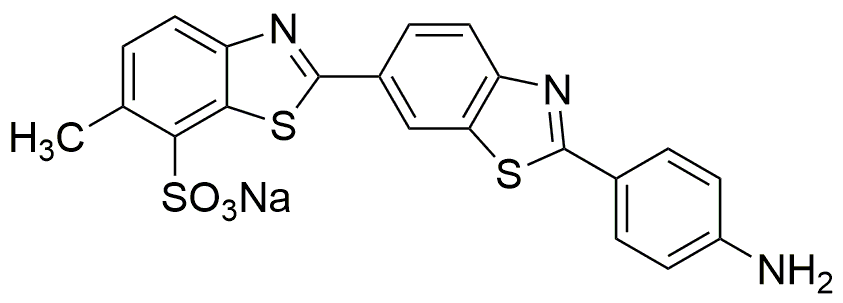Primuline is widely utilized in research focused on:
- Textile Industry: It serves as a dye for fabrics, providing vibrant colors and excellent lightfastness, making it ideal for high-quality textile applications.
- Biological Staining: Primuline is used in microscopy for staining biological samples, particularly in the identification of certain microorganisms, enhancing visibility under UV light.
- Environmental Monitoring: This compound is applied in studies assessing water quality, where it helps in detecting pollutants and assessing the health of aquatic ecosystems.
- Pharmaceutical Research: Primuline is utilized in drug formulation and development, particularly in creating targeted delivery systems due to its unique chemical properties.
- Food Industry: It finds application as a food colorant, providing a safe and effective way to enhance the visual appeal of various food products.
General Information
Properties
Safety and Regulations
Applications
Primuline is widely utilized in research focused on:
- Textile Industry: It serves as a dye for fabrics, providing vibrant colors and excellent lightfastness, making it ideal for high-quality textile applications.
- Biological Staining: Primuline is used in microscopy for staining biological samples, particularly in the identification of certain microorganisms, enhancing visibility under UV light.
- Environmental Monitoring: This compound is applied in studies assessing water quality, where it helps in detecting pollutants and assessing the health of aquatic ecosystems.
- Pharmaceutical Research: Primuline is utilized in drug formulation and development, particularly in creating targeted delivery systems due to its unique chemical properties.
- Food Industry: It finds application as a food colorant, providing a safe and effective way to enhance the visual appeal of various food products.
Documents
Safety Data Sheets (SDS)
The SDS provides comprehensive safety information on handling, storage, and disposal of the product.
Product Specification (PS)
The PS provides a comprehensive breakdown of the product’s properties, including chemical composition, physical state, purity, and storage requirements. It also details acceptable quality ranges and the product's intended applications.
Certificates of Analysis (COA)
Search for Certificates of Analysis (COA) by entering the products Lot Number. Lot and Batch Numbers can be found on a product’s label following the words ‘Lot’ or ‘Batch’.
*Catalog Number
*Lot Number
Certificates Of Origin (COO)
This COO confirms the country where the product was manufactured, and also details the materials and components used in it and whether it is derived from natural, synthetic, or other specific sources. This certificate may be required for customs, trade, and regulatory compliance.
*Catalog Number
*Lot Number
Safety Data Sheets (SDS)
The SDS provides comprehensive safety information on handling, storage, and disposal of the product.
DownloadProduct Specification (PS)
The PS provides a comprehensive breakdown of the product’s properties, including chemical composition, physical state, purity, and storage requirements. It also details acceptable quality ranges and the product's intended applications.
DownloadCertificates of Analysis (COA)
Search for Certificates of Analysis (COA) by entering the products Lot Number. Lot and Batch Numbers can be found on a product’s label following the words ‘Lot’ or ‘Batch’.
*Catalog Number
*Lot Number
Certificates Of Origin (COO)
This COO confirms the country where the product was manufactured, and also details the materials and components used in it and whether it is derived from natural, synthetic, or other specific sources. This certificate may be required for customs, trade, and regulatory compliance.

